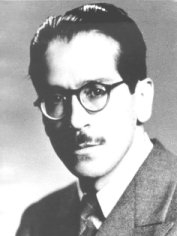The Alliance of Nationalist Left Forces of the MNR (Spanish: Alianza de Fuerzas de la Izquierda Nacional del MNR, AFIN-MNR) was a leftist political party in Bolivia.
Spanish, or Castilian, is a Romance language that originated in the Iberian Peninsula and today has over 450 million native speakers in Spain, the Americas and a small part of Africa. It is a global language and the world's second-most spoken native language, after Mandarin Chinese.
A political party is an organized group of people who have the same ideology, or who otherwise have the same political positions, and who field candidates for elections, in an attempt to get them elected and thereby implement the party's agenda.

Bolivia, officially the Plurinational State of Bolivia, is a landlocked country located in western-central South America. The capital is Sucre, while the seat of government and financial center is located in La Paz. The largest city and principal industrial center is Santa Cruz de la Sierra, located on the Llanos Orientales, a mostly flat region in the east of the country.
In 1980 the left-wing group split from the Revolutionary Nationalist Movement and founded the Alliance of Nationalist Left Forces of the MNR. Led by Roberto Jordán Pando. [1]

The Revolutionary Nationalist Movement is a Bolivian political party and the leading force behind the Bolivian National Revolution. It influenced much of the country's history since 1941.
In 1980 elections the AFIN-MNR presented Roberto Jordán Pando as presidential candidate; he won 1.31 per cent of the vote. [2]
In 1984 the AFIN-MNR merged with the Leftwing Revolutionary Nationalist Movement (MNRI).
The Leftwing Revolutionary Nationalist Movement was a centre-left political party in Bolivia.
In 1985 elections the MNRI presented Roberto Jordán Pando as presidential candidate.

Hernán Siles Zuazo was a Bolivian politician who served as constitutionally elected president twice, from 1956 to 1960 and again from 1982 to 1985. He also briefly served as the temporary president in April 1952, and as vice president between 1952 and 1956.

The Christian Democratic Party is a Christian-democratic political party in Bolivia.
The Revolutionary Left Movement - New Majority is a social democratic political party in Bolivia. It was a member of the Socialist International.

The Revolutionary Party of the Nationalist Left was a left-wing political party in Bolivia. It was founded in 1963 by the labor leader Juan Lechín Oquendo and by Mario Torres Calleja and Edwin Moller in lesser roles. The PRIN seceded from the Revolutionary Nationalist Movement (MNR) in protest against Víctor Paz Estenssoro's decision to seek a third elected term as president in 1964, rather than permit then Vice-President Juan Lechín to have the MNR's presidential nomination.
The Democratic and Popular Union (1977–84) was a Bolivian umbrella political alliance uniting various smaller left-wing parties. It was formed in 1977 by former president Hernán Siles Zuazo and consisted chiefly of Siles' Movimiento Nationalista Revolutionario de Izquierda, a spin-off of the Moviminento Nacionalista Revolucionario, and Jaime Paz Zamora's Movimiento de Izquierda Revolucionaria. The coalition became extremely popular with Bolivian voters in the late 1970s, due to fatigue with the military dictatorships that for the most controlled the country since 1964.

The 2010 Bolivian regional elections were held on 4 April 2010. Departmental and municipal authorities were elected by an electorate of approximately 5 million people. Among the officials elected are:

The Revolutionary Left Front is a political party in Bolivia, founded in 1978.
The Leftwing Revolutionary Nationalist Movement – 1 was a political party in Bolivia, that emerged as a splinter-group of the Revolutionary Nationalist Leftwing Movement (MNRI) ahead of the 1985 elections. MNRI-1 was formed by a peasant sector. The presidential candidate of MNRI-1 was Francisco Figueroa and their candidate for vice president was Marcos Chuquimia. The Figueroa-Chuquimia ticket obtained 11,696 votes.

General elections were held in Bolivia on 7 May 1989. As no candidate for the presidency received over 50% of the vote, the National Congress was required to elect a President on 6 August. Although the Revolutionary Nationalist Movement had received the most votes, its candidate for President Gonzalo Sánchez de Lozada was defeated by Jaime Paz Zamora of the Revolutionary Left Movement (MIR) in the Congressional vote, despite the MIR only finishing third in the public vote.
The Mining Parliamentary Bloc was an electoral political alliance of the Revolutionary Nationalist Movement (MNR) and Revolutionary Workers' Party (POR) in Bolivia.
The Authentic Revolutionary Party was a political party in Bolivia.
The Nationalist Union of the People was a right-wing, pro-military electoral political alliance in Bolivia.
The Movement of the National Left was a left-wing political party in Bolivia.
The Tupac Katari Revolutionary Movement is a left-wing political party in Bolivia.
The Democratic Alliance of National Revolution was a centrist electoral political alliance in Bolivia.
The Revolutionary Nationalist Movement–Alliance was a centrist electoral political alliance in Bolivia.
The Revolutionary Nationalist Movement–Julio was a pro-military political party in Bolivia.
The Bolivian National Congress 1979–1980 was elected on 1 July 1979.
This page is based on this
Wikipedia article Text is available under the
CC BY-SA 4.0 license; additional terms may apply.
Images, videos and audio are available under their respective licenses.





